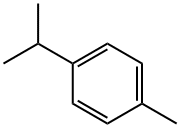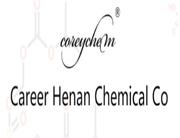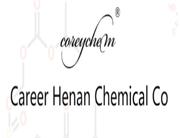| Description |
4-isopropyltoluene (also p-Cymene) is colorless liquid with a strong, characteristic odor reminiscent of carrot. It tends to darken with aging. It occurs naturally in orange peel oil, mandarin peel oil, satsuma mandarin peel oil, coldpressed lime peel oil, distilled lime peel oil, cinnamon leaf, etc. 4-isopropyltoluene has antimicrobial properties. It is used as a flavor ingredient permitted for direct addition to food for human consumption. |
| References |
[1] George A. Burdock, Encyclopedia of Food and Color Additives, Volume 1, 1996
[2] C.F. Bagamboula, M. Uyttendaele and J. Debevere, Inhibitory effect of thyme and basil essential oils, carvacrol, thymol, estragol, linalool and p-cymene towards Shigella sonnei and S. flexneri, Food Microbiology, 2004, vol. 21, 33-42 |
| Chemical Properties |
colourless liquid with a characteristic odour |
| Definition |
ChEBI: A monoterpene that is toluene substituted by an isopropyl group at position 4. |
| General Description |
Colorless liquid with a mild pleasant odor. Floats on water. |
| Air & Water Reactions |
Insoluble in water. |
| Reactivity Profile |
Vigorous reactions, sometimes amounting to explosions, can result from the contact between aromatic hydrocarbons, such as CYMENE, and strong oxidizing agents. They can react exothermically with bases and with diazo compounds. Substitution at the benzene nucleus occurs by halogenation (acid catalyst), nitration, sulfonation, and the Friedel-Crafts reaction. |
| Health Hazard |
Inhalation causes impairment of coordination, headache. Contact with liquid causes mild irritation of eyes and skin. Ingestion causes irritation of mouth and stomach. |
| Fire Hazard |
HIGHLY FLAMMABLE: Will be easily ignited by heat, sparks or flames. Vapors may form explosive mixtures with air. Vapors may travel to source of ignition and flash back. Most vapors are heavier than air. They will spread along ground and collect in low or confined areas (sewers, basements, tanks). Vapor explosion hazard indoors, outdoors or in sewers. Runoff to sewer may create fire or explosion hazard. Containers may explode when heated. Many liquids are lighter than water. |
| Safety Profile |
Mildly toxic by ingestion. Humans sustain central nervous system effects at low doses. A skin irritant. Flammable liquid. Explosion Hazard: Slight in the form of vapor. To fight fire, use foam, CO2, dry chemical. When heated to decomposition it emits acrid smoke and fumes. |
| Purification Methods |
Wash p-cymene with cold, conc H2SO4 until there is no further colour change, then repeatedly with H2O, 10% aqueous Na2CO3 and H2O again. Dry it over Na2SO4, CaCl2 or MgSO4, and distil it. Further purification steps include steam distillation from 3% NaOH, percolation through silica gel or activated alumina, and a preliminary reflux for several days over powdered sulfur. Store it over CaH2. [Beilstein 5 IV 1060.] |

 China
China







